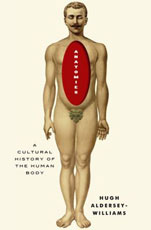"These are exciting and troubling times for the human body," writes Hugh Aldersey-Williams in the introduction to Anatomies: "We seem both excessively aware of it and yet at the same time profoundly dissatisfied with it. The biological sciences promise many things about the way we will live in the future. But, however beautiful we are, however super-capable we become, however long we live, we still must inhabit our bodies. Perhaps, by recognizing the human body as a site of continual invention, we may overcome the distortions of the present moment."
Here is a fresh and fascinating treatise on the human body, its parts and the multiple meanings and responses to it by scientists, artists, writers, and healers. Beginning with his assessment of Rembrandt's painting known as "The Anatomy Lesson of Doctor Tulp," Aldersey-Williams moves into an account seeing a body being dissected. We sense that we are in the hands of a gifted writer who is ready, willing, and able to take us on an exciting and wide-ranging tour of the human body.
Whether Aldersey-Williams is writing about phrenology, tattooing, organ donations, genes, X-rays or liposuction, he keeps us alert to the mysteries, quirks, and miracles of the flesh. Here is a brief sampler of interesting facts about the body from the book:
• The heart and the eyes are the organs most often excluded from donations.
• Left-handers die younger.
• Human flesh tastes like pork.
• Ancient human beings were capable of running 23 miles per hour.
• The body is our most immediate and familiar source of linguistic expression.
• Eyes are said to be the window on the soul.
• A footprint is a relic of dynamic human action in the past.
• One of art's greatest challenges is painting flesh.
